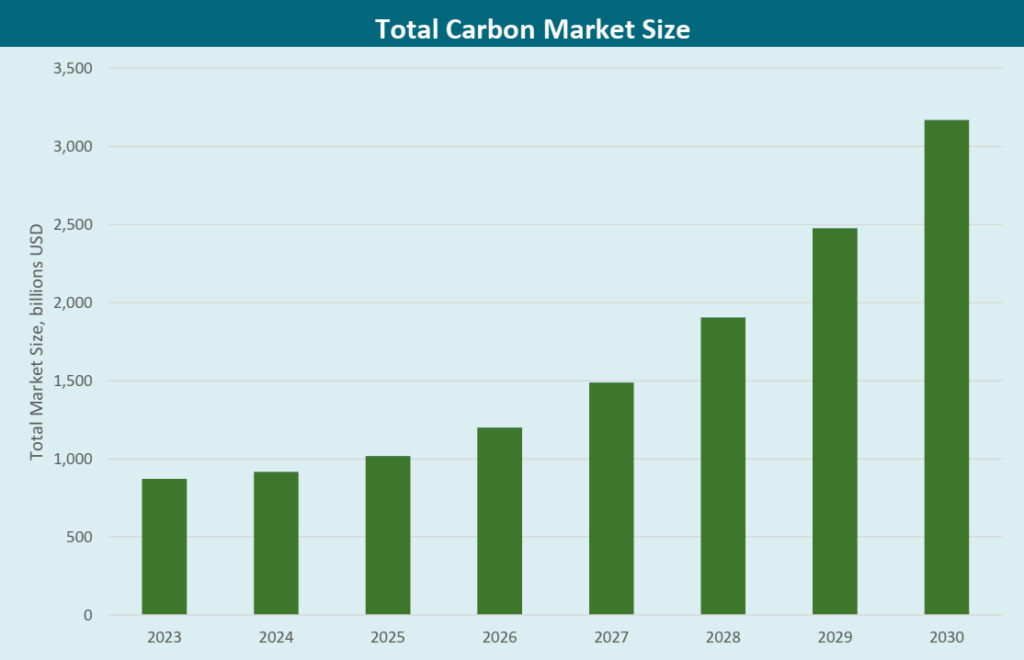Decoding Carbon Removal: Innovative Methods for Removing Greenhouse Gas
Decoding Carbon Removal: Innovative Methods for Removing Greenhouse Gas
-
Author : Ken Rietz
Date : July 5, 2023
There are several different avenues of approach that have emerged to combat climate change. One is carbon reduction which includes the removal of carbon from the atmosphere. Subsequently, a new carbon trading sector has emerged and carbon emissions has become one of the fastest-growing asset classes in the world. Global carbon markets have grown at a rate of 40% over the last 5 years and the new sector has the potential to reach trillions of dollars by 2030, as displayed in the chart below:

These carbon trading markets have created an economic incentive to develop and ramp up methods for removing carbon from the atmosphere. Below, we summarize Bloomberg’s white paper Scaling Carbon Removal which explains the three primary methods for removing carbon dioxide from the atmosphere: direct air capture (DAC), land-based removal, and ocean-based removal. While there is no single method of dealing with carbon dioxide that is currently adequate to deal with the existing problem, a combination of methods might at the very least help to mitigate it.
Direct Air Capture (DAC):
There are two basic approaches to capture carbon dioxide via DAC: either bubble it through a liquid that specifically absorbs carbon dioxide or blow it through a porous solid to which carbon dioxide will adsorb. In both cases, it is normal to remove the captured carbon dioxide and move it to permanent storage and reuse the solid or liquid to capture more carbon dioxide.
The cost of freeing up the carbon dioxide runs between $250 to more than $500 per ton of carbon. This is far more expensive than the current ceiling cost (determined by the value of carbon offsets) of $100 per ton. Clearly, research on developing materials that can capture and release carbon dioxide more cheaply is essential before DAC can be considered for large-scale carbon removal.
There is another issue with DAC: The carbon that is captured and removed must be stored. Two fundamental ways of storing carbon dioxide are currently proposed, and both involve modifying the carbon dioxide and storing it underground. This invariably involves subsurface geological risks, but is relatively cheap, at less than $30 per ton.
Overall, if the excessive cost issue can be resolved, this method would be the best alternative for large-scale removal of carbon dioxide, but not until then.
Land-based sequestration
Land-based sequestration of carbon dioxide uses some combination of vegetation and soil to remove carbon dioxide from the atmosphere. At first glance, this seems to be the most obvious method, but it does have serious problems, not all of which have clear answers.
The basic reason this works is simple: as vegetation grows, it uses atmospheric carbon dioxide in the process of growth. Gathering up and processing the vegetation, therefore, removes carbon. Here are the difficulties, together with partial or potential solutions.
Vegetation can also be reduced to its carbon content by pyrolysis, heating the biomass with no oxygen, creating biochar, much the way charcoal is formed. Storing large amounts of biochar presents some difficulties as only a limited amount could be incorporated back into the soil.
There is also the potential conflict between growing carbon capture vegetation and growing food. This is particularly true for trees, which need large forests on arable land. Genetic modification of trees would help increase the amount of carbon that trees capture but with unknown consequences.
Overall, this oldest method of carbon capture is inadequate. It is inherently limited in scale and can take a long time to capture much carbon (at least for trees) and has biodiversity/ecology/genetics risks.
Ocean-based sequestration
The ocean is a natural reservoir of carbon dioxide. It absorbs 9.5 billion tons of carbon each year automatically and contains 45 times as much carbon as the atmosphere and 12 times as much carbon as the land. It could absorb all anthropogenic carbon produced in a year and increase its amount of carbon by about 1%. But as with all other approaches to carbon capture, there are problems. Big problems.
There are two basic methods of getting more carbon into the ocean. One is to grow vegetation (mainly seaweed) and sink it to the bottom of the ocean. The other is to treat ocean water to absorb more carbon dioxide. The difficulties are nearly insuperable because the area of the oceans is vast.
The seaweed approach would build rafts that seaweed could grow on. When the amount of seaweed reaches some preset weight, the raft would sink, carrying the seaweed to the bottom of the ocean, where it would stay for roughly 1,000 years. This is sufficiently long to be considered permanent. To sink to a sufficient depth, the raft would have to be beyond the continental shelf, quite distant from the shore. Any attempt to cover a significant portion of the ocean with rafts would certainly devastate large portions of the ocean’s ecology.
The other method attempts to pump coastal ocean water onto land and treat it to capture more carbon dioxide and then return it. The treatment is either adding various minerals to make the water more alkaline or by electrochemically removing acidic components of the water. But the difficulty again is that the ocean is very big. If you could treat all the water within 1 kilometer of all shores, you would treat much less than 0.0003% of the ocean. This is not going to be adequate, and that again ignores the ecological damage that the treatment could inflict.
Despite the potential of using the ocean for carbon capture, there doesn’t appear to be any practical and ecologically sensitive way to accomplish it.
